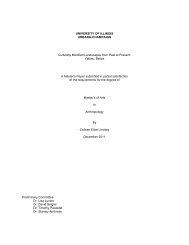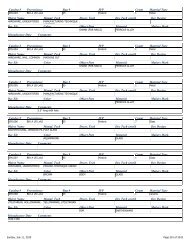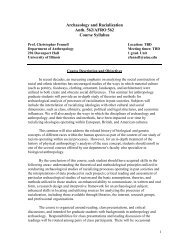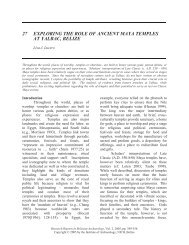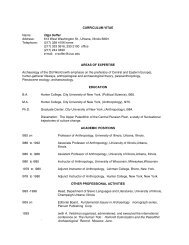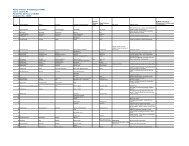Materialized Cosmology among Ancient Maya Commoners.
Materialized Cosmology among Ancient Maya Commoners.
Materialized Cosmology among Ancient Maya Commoners.
Create successful ePaper yourself
Turn your PDF publications into a flip-book with our unique Google optimized e-Paper software.
144 Journal of Social Archaeology 10(1)The north cobble had two white lines, the south cobble had one yellow line,the west cobble was half black and half red with the black half towards thewest and the red half towards the east, and at the center of these was abroken and heavily battered fragment of a greenstone axe. (2002: 255)This cosmological patterning comes from a long tradition. For example,at Cival, Guatemala, Cache 4 (c.600 BC) in the E-Group Plaza includes fivejars; four were positioned at the cardinal directions and one in the center,symbolizing not only the quadripartite division of the <strong>Maya</strong> universe, butits association with the Maize God (Estrada-Belli, 2006). Further, the <strong>Maya</strong>placed the only non-black jar, a red one, on the east side of the cache.The shape and alignment of ritual deposits comprise part of the map aswell, via the cross motif and quadripartite divisions (Kunen et al., 2002;McAnany et al., 1999; Vogt, 1998). For instance, <strong>among</strong> the contemporaryZinacantecos of Chiapas, Mexico, the cross symbolizes ancestral gods andthe house’s soul (Vogt, 1993). The alignment of artifacts divides the homeinto quarters; and since most are termination deposits, they are sooncovered over with a new floor to create a domestic underworld. Artifactsare often found in groups or layers of three, one of the most significantnumbers in <strong>Maya</strong> cosmology, reflecting the three layers of the universe(Garber et al., 1998). The underworld was also recreated when occupantsdug into floors and placed items and interred the deceased.Offerings found in cached lip-to-lip vessels can also signify the threelayers of heaven, earth, and either the primordial sea or the underworld.For the former, the domed lid represents heaven; jade, hematite, red ochre,cacao, foodstuff, and stones the earth; and sponges, stingray spines, shell,and coral the sea (Bozarth and Guderjan, 2004; Guderjan, 2004). For thelatter, heaven is represented by the empty space under the domed lid; theearth by twigs and rodent bones; and the underworld by marl and nineflakes representing the levels of the underworld (Garber et al., 1998).The <strong>Maya</strong> passed down heirloom objects until either broken accidentallyor purposefully; either way, they required burial. Even these fragmentedobjects play a role. Chapman (2000), based on his work on Mesolithic andNeolithic Balkan artifact assemblages, suggests that the life history ofparticular objects continued long after people purposefully or accidentallybroke them. In this sense, objects were part of the enchainment processwhereby people created relationships with others through fragments. Thus,objects were purposefully broken, exchanged and eventually ceremoniouslydeposited ‘throughout the settlement and beyond’ (Chapman, 2000: 23),resulting in ‘a geography of social relations’ (Pollard, 2008: 52).One type of artifact offered by all <strong>Maya</strong> is groundstone: metates andmanos, fragmented or whole (Garber, 1986). These sacrificed tools, used togrind maize, represent the never-ending importance of maize in daily life.The <strong>Maya</strong> also deposited obsidian and chert items. Chert was believed tohave been created by lightning and was also used to start fires for the godsDownloaded from http://jsa.sagepub.com at UNIV OF ILLINOIS URBANA on March 28, 2010



